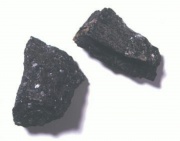Difference between revisions of "Amphibole"
Jump to navigation
Jump to search
m (Text replace - "== Authority ==" to "== Sources Checked for Data in Record ==") |
|||
| Line 14: | Line 14: | ||
|} | |} | ||
| − | == | + | == Sources Checked for Data in Record == |
* R.F.Symmes, T.T.Harding, Paul Taylor, ''Rocks, Fossils and Gems'', DK Publishing, Inc., New York City, 1997 | * R.F.Symmes, T.T.Harding, Paul Taylor, ''Rocks, Fossils and Gems'', DK Publishing, Inc., New York City, 1997 | ||
Revision as of 13:32, 29 April 2016
Description
One of the major classes of silicate minerals. Amphiboles, in general, are a series of doubly hydrated silicates containing either Sodium, Calcium, Magnesium, Iron, or Aluminum. They are distinguished from pyroxenes, a second major class, by their cleavage planes. Amphiboles have cleavage angles of 56 and 124 degrees while pyroxenes have cleavage angles of 5 and 93 degrees. Amphiboles are commonly found in both Igneous and Metamorphic rocks. Examples of some amphibole minerals are: Hornblende, Glaucophane, amphibolite, actinolite, and Tremolite.
Synonyms and Related Terms
amfibol (Ces., Sven.); Amphibol (Deut.); amphibole (Fr.); amfibool (Ned.); amfibole (Pol.); anfíbola (Port.); (Sven.)
| Density | 2.9-3.2 |
|---|
Sources Checked for Data in Record
- R.F.Symmes, T.T.Harding, Paul Taylor, Rocks, Fossils and Gems, DK Publishing, Inc., New York City, 1997
- Wikipedia, the free encyclopedia, at http://www.wikipedia.com Comment: http://en.wikipedia.org/wiki/Amphibole (Accessed Mar. 20, 2006) -for non-English terms
- CRC Handbook of Chemistry and Physics, Robert Weast (ed.), CRC Press, Boca Raton, Florida, v. 61, 1980 Comment: density=2.9-3.2
- Random House, Webster's Encyclopedic Unabridged Dictionary of the English Language, Grammercy Book, New York, 1997
- The American Heritage Dictionary or Encarta, via Microsoft Bookshelf 98, Microsoft Corp., 1998
